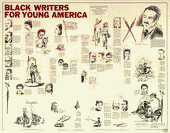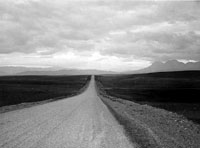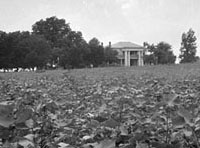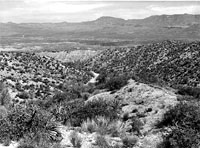
HOME
- EXHIBITION OVERVIEW
- OBJECT LIST
SECTIONS:
Introduction -
Northeast -
South -
Midwest -
West
Introduction
America always! . . . .
Always the prairies, pastures, forests, vast cities, travelers, Kanada, the snows;
Always these compact lands -- lands tied at the hips with the belt stringing the huge oval
lakes;
Always the West, with strong native persons
All sights, South, North, East -- all deeds, promiscuously done at all times,
All characters, movements, growths. . . .
Walt Whitman, American Vistas
|
From Robert Frost's New England
farms to John Steinbeck's California valleys to Eudora Welty's Mississippi Delta, American
authors have shaped our view of America's regional landscapes in all their astonishing variety.
They have created unforgettable characters, inseparably identified with the territory they inhabit.
The Yearling's wandering in the Florida woods, Paul Bunyan and Babe the Blue Ox's exploits in
the dark northern pines, Huckleberry Finn and Jim's adventures on the Mississippi River, and the
Joad family's exhausting trek to California have become an enduring part of the American
imagination. Language of the Land uses the metaphor of a journey to tour this rich
literary heritage through maps, the words of authors, images of characters, and photographs.
Given the country's history as a nation of immigrants, it is not surprising that a major theme of
American literature is exploration, the need to see what is over the horizon. In addition to Jack
Kerouac, a number of writers have gone "on the road" and left memorable records of their travels
around the United States. The keen observations of these roving authors form introductions to the
sections in Language of the Land.
The exhibit's four regional sections feature the voices of writers deeply rooted in a particular
place. These local writers create an enduring sense of place and of the vast differences among
America's regions.
The inspiration for this exhibition was the Library of Congress's collection of literary
maps--maps that acknowledge the contributions of authors to a specific state or region as well as
those that depict the geographical locations in works of fiction or fantasy. Throughout the
exhibition, these colorful and varied maps reflect the contributions of authors to specific states or
regions and locate their imagined people and places. Through these maps, authors' words,
images, and characters, Language of the Land presents a tapestry of the impressions
that endure in our collective imagination of the American land and its culture.
Language of the Land is part of the Literary Heritage of the States project of the Center for the
Book in the Library of Congress. It was developed by the Library's Interpretive Programs Office
in cooperation with the Geography and Map Division. The Center for the Book in the Library of
Congress was established in 1977 to stimulate public interest in books, reading, and
libraries.
This exhibition was made possible by a generous grant from the Lila Wallace-Readers
Digest Fund. Additional support was provided by the James Madison Council of the Library of
Congress.
|
 The Booklover's Map of the United States
The Booklover's Map of the United States
Amy Jones, Designer and Illustrator
New York: R.R. Bowker, 1949
Geography & Map Division (1)
|
|
What interests me is the waking in the morning, the progress from the familiar to the slightly
odd, to the rather strange, to the totally foreign, and finally to the outlandish. The journey, not
the arrival, matters; the voyage, not the landing.
Paul Theroux, The Old Patagonian Express: By Train Through the Americas
|
 A Pictorial Chart of American Literature
A Pictorial Chart of American Literature
Ella Van Wall Leer, Illustrator
Rand McNally, 1932
Geography & Map Division (3)
|
America is neither a land nor a people,
A word's shape it is, a wind's sweep--
America is alone: many together
Many of one mouth, of one breath.
Archibald MacLeish, "It is a Strange Thing to Be An American"
|
 Black Writers for Young America
Black Writers for Young America
Rachel Davis, Illustrator
Washington, D.C.: District of Columbia Council of Teachers of English, 1976
Courtesy of the District of Columbia Council of Teachers of English
Geography & Map Division (5)
|
And if we keep
Our love for this American earth, black fathers,
O black mothers, believing that its fields
Will bear for us at length a harvesting
Of sun, it is because your spirits walk
Beside us as we plough; it is because
This land has grown from your great, deathless hearts.
Robert Hayden, "We Have Not Forgotten"
|
 The Beat Generation Map of America
The Beat Generation Map of America
Stan Grant, Illustrator
Los Angeles: Aaron Blake, 1987
Courtesy of Molly Maguire and Aaron Silverman
Geography & Map Division (6)
|
|
I see a vision of a great rucksack revolution, thousands or even millions
of young Americans wandering around with rucksacks, going up to
mountains to pray, making children laugh and old men glad, making
young girls happy and old girls happier, all of 'em Zen Lunatics who go
about writing poems that happen to appear in their heads for no reason
and also by being kind and also by strange unexpected acts keep giving
visions of eternal freedom to everybody and to all living creatures. . . .
Jack Kerouac, The Dharma Bums
|
 Road to Glacier National Park, Montana
Road to Glacier National Park, Montana
August 1941
Marion Post Wolcott, Photographer
FSA-OWI Collection
Prints & Photographs Division (7)
|
|
So in America when the sun goes down and I sit on the old broken-down river pier watching the
long, long skies over New Jersey and sense all that raw land that rolls in one unbelievable huge
bulge over to the West Coast, and all that road going, all the people dreaming in the immensity
of it. . . .
Jack Kerouac, On the Road
|
 A cotton field and plantation house, Macon, Georgia
A cotton field and plantation house, Macon, Georgia
July 1937
Dorothea Lange, Photographer
FSA-OWI Collection
Prints & Photographs Division (8)
|
From Paumanok I fly like a bird,
Around and around to soar to sing the idea of all
To Wisconsin, Iowa, Minnesota, to sing their songs, (they are inimitable;)
Then to Ohio and Indiana to sing theirs, to Missouri and Kansas and Arkansas to sing theirs,
To Tennessee and Kentucky, to the Carolinas and Georgia to sing theirs,
To Texas and so along up toward California, to roam accepted everywhere;
To sing first (to the tap of the war-drum if need be,)
The idea of all, of the Western world one and inseparable,
And then the song of each member of these States.
Walt Whitman, "From Paumanok Starting I Fly Like a Bird"
|
 Looking north over the Savoy Mountain Range of the Berkshire Mountains,
Massachusetts
Looking north over the Savoy Mountain Range of the Berkshire Mountains,
Massachusetts
John Collier, Photographer
FSA-OWI Collection
Prints & Photographs Division (9)
|
|
The woods were as still, and apparently . . . as much untenanted, as when they came fresh from the
hands of their Almighty Creator. The eye could range in every direction through the long and
shadowed vistas of the trees; but nowhere was any object to be seen that did not properly belong
to the peaceful and slumbering scenery. . . . Across the tract of wilderness . . . it seemed as if the foot
of man had never trodden, so breathing and deep was the silence in which it lay.
James Fenimore Cooper, The Last of the Mohicans
|
 Portland Head Light, Maine
Portland Head Light, Maine
1935
John Marshall, Photographer
Prints & Photographs Division (10)
|
|
I wished to see that seashore where man's works are wrecks; to put up at
the true Atlantic House, where the ocean is land-lord as well as sea-lord,
and comes ashore without a wharf for the landing. . . . the roaring of the
breakers, and the ceaseless flux and reflux of the waves [which] did not
for a moment cease to dash and roar, with such a tumult. . . .
Henry David Thoreau, Cape Cod
|
 Desert scene along the Apache Trail, Gila County, Arizona
Desert scene along the Apache Trail, Gila County, Arizona
April 1940
Russell Lee, Photographer
FSA-OWI Collection
Prints & Photographs Division (11)
|
|
I had never been away from home, and that word "travel" had a seductive charm for me. . . . I
dreamed all night about Indians, deserts, and silver bars, and in due time, next day, we took
shipping at the St. Louis wharf on board a steamboat bound up the Missouri River.
Mark Twain, Roughing It
|
 Gallipolis, Ohio
Gallipolis, Ohio
May 1943
Arthur Siegal, Photographer
FSA-OWI Collection
Prints & Photographs Division (12)
|
|
I drove into the street, around the corner, through the intersection, over the bridge, onto the
highway. I was heading toward those little towns that get on the map if they get on at all -- only
because some cartographer has a blank space to fill: Remote, Oregon; Simplicity, Virginia; New
Freedom, Pennsylvania; New Hope, Tennessee; Why, Arizona; Whynot, Mississippi; Igo,
California (just down the road from Ono), here I come.
William Least Heat Moon, Blue Highways
|
HOME
- EXHIBITION OVERVIEW
- OBJECT LIST
SECTIONS:
Introduction -
Northeast -
South -
Midwest -
West
Go to:
 Library of Congress
Library of Congress
Contact Us
(11/04/99)
|

